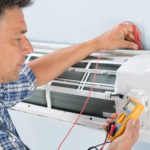
An exciting year lies ahead for HVAC installers and the construction industry. Here’s a few business and climate control trends that may affect you in 2016.
HVAC Companies Will Get Busier
Stricter regulations for emissions and efficiency are becoming widespread across North America meaning new buildings are getting greener. The construction industry in the U.S. is rebounding and there are a huge number of new homes getting built. Combined with the new standards this will lead to even greater demand for high efficiency and smart HVAC systems and controls in 2016.
This means HVAC contractors will be busier than ever retrofitting existing systems to higher standards and installing HVAC in new builds. Not only will buildings need to be more efficient but the installers themselves! New technologies are available to run remote diagnostics and preventative maintenance. Also, as installers need to expand their capabilities, mobile apps that help in scheduling and dispatching will be essential.
Geothermal Makes a Comeback
Geothermal heat pumps have been around for a while but recently they started to be officially recognized as a clean and renewable energy source. This type of heat pump uses the consistent temperature of the Earth several feet underground. The temperature here is normally warmer than the atmosphere in winter and cooler in summer. Refrigerant is pumped through a heat exchanger in the ground where heat is absorbed in the cooler months or discharged in the warmer months.
The problem has been that the initial capital cost of installing the system – especially digging up the ground for the heat exchanger – has been prohibitive to most homeowners and builders. However, the costs in the long term can be much less than conventional heating and cooling. Today, geothermal utilities are coming to market that charge a one-time connection fee and a monthly amount that spreads the costs over time.
Adaptable Radiant Heating
Alongside renewable energy sources radiant heating is in vogue once more. It can be highly efficient and has become more adaptable. It can use hot water in buried heating tubes or electric elements and can be coupled directly with a geothermal heat pump, conventional furnace or hydronic system.
Personalized Heating
A mini split heat pump uses the same technology as an air source heat pump but in a small package that can be installed in individual rooms. Like all air source heat pumps the cooling cycle uses refrigerant in a coil inside the house, which acts as an evaporator. The low-pressure liquid vaporizes absorbing heat. The hot vapor is then compressed and heat is released from the outside coil, which acts as a condenser returning the hot gas to a cooler liquid. The cycle is reversed in the cooler months so that heat is released inside the house and the evaporator and condenser switch roles.
The mini split heat pump is a ductless system making it more efficient as ductwork can account for significant energy loss in conventional systems. These pumps are also easier to install and ideal for places where accommodating ductwork is an issue. Their small size allows multiple climate zones each with its own thermostat and as many as eight air handlers being connected to a single outdoor unit. This unit can be connected through a small hole in the wall from up to fifty feet away allowing it to be located in an ideal location.



